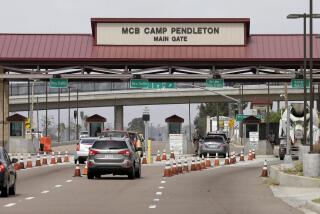Copters in Anti-Drug Patrol Crash, Killing 4 Marines
- Share via
FALCON HEIGHTS, Texas — Two military helicopters taking part in a nighttime anti-drug patrol crashed and burned in the dusty scrubland near the Mexican border, killing all four Marine reservists on board.
The AH-1W Super Cobra helicopters went down Wednesday night amid the brush and cactus of Falcon State Park, about 110 miles northwest of Brownsville, officials said.
Marine Corps spokesman Capt. Joe Kloppel said he had no immediate information on the cause of the crash. However, witnesses said they saw the helicopters collide.
“They definitely collided,” said resident Norman Ross, 63. “You heard the explosion.... We could feel a slight vibration in our camper from it.”
Another resident, Larry Sholl, said he “heard a loud boom and all of a sudden the engines in the helicopters quit, so I went outside and looked and there was a ball of fire.” He said he saw another fireball close by.
“There was nobody that could have survived that,” said Sholl, 67. “There was no way to help them.”
Each unarmed helicopter carried a crew of two from Camp Pendleton, Calif., but was operating out of the Army’s Ft. Bliss in El Paso.
The victims were identified as Lt. Col. Robert Theilmann, 47, of Suffolk, N.Y.; Majs. John Walsh, 36, of Oakland, Mich., and Steven Palombo, 36 of Sterling Heights, Mich.; and Capt. David Cross, 34, of Centre, Pa.
Two other helicopters involved in the operation landed safely, said Marine Forces Reserve spokesman Al Foucha. He did not know how close they were to the two that crashed.
Officials said the helicopters were assisting the Border Patrol as part of Joint Task Force Six, a Pentagon unit that takes part in anti-drug operations and other missions.
“The helicopters were conducting nighttime aviation reconnaissance counter-drug operations,” said Armando Carrasco, a spokesman for Joint Task Force Six.
A detachment of six helicopters and 53 Marines was deployed to the region Jan. 17, authorities said. Their mission has been suspended.
The Super Cobra is included in the military buildup in the Persian Gulf for a possible war in Iraq, and has seen extensive action in Afghanistan and during the 1991 Gulf War, Kloppel said.
“It’s a very safe aircraft, as aircraft go, and its safety record has been very good throughout its history,” Kloppel said.
*
(BEGIN TEXT OF INFOBOX)
About the Cobras
AH-1W Super Cobra
Primary function: All-weather day/night attack helicopter
Length: 58 feet
Height: 14.5 feet
Maximum speed: 175 mph
Ceiling: 15,786 feet
Range: 365 miles
Armaments: One 20 millimeter cannon; four external wing stations to hold rockets and missiles
Sources: Federation of American Scientists, U.S. Marine Corps
More to Read
Sign up for Essential California
The most important California stories and recommendations in your inbox every morning.
You may occasionally receive promotional content from the Los Angeles Times.












